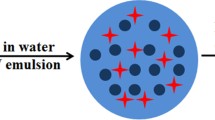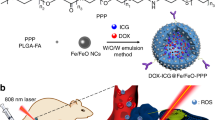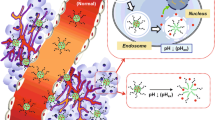Abstract
Nanocapsule-based targeted delivery and stimulus-responsive release can increase drug effectiveness, while reducing the side effects of the drug. However, difficulties in the scale-up synthesis, fast burst release, and low degradability, could hamper the translation of drug nanocapsules from lab to clinic. Here we have controllably functionalized the biodegradable and widely available polysuccinimide, in order to obtain an amphiphilic poly(amino acid). Using this polymer, we designed nanocapsules (< 100 nm) for hydrophobic drug delivery, which could facilitate tumor targeting, hydrogen bond-based pH-responsive release, and real-time fluorescence tracking, in the second near-infrared region. This method is versatile, eco-friendly, and easy to scale up at low costs. In addition, this system can carry a cocktail of drugs, obtained by loading multiple anticancer drugs to the same vehicle. Our nanocapsules were observed to be stable in blood vessels (pH = 7.4), and the pH-responsive release (pH = 5.0 in lysosome) was sustained. The chemotherapy results in tumor-xenografted mice suggested that our nanocapsule was safe and efficient, and may be a useful tool for drug delivery.

Similar content being viewed by others
References
Sugano, K.; Kansy, M.; Artursson, P.; Avdeef, A.; Bendels, S.; Di, L.; Ecker, G. F.; Faller, B.; Fischer, H.; Gerebtzoff, G. et al. Coexistence of passive and carrier-mediated processes in drug transport. Nat. Rev. Drug Discovery 2010, 9, 597–614.
Petros, R. A.; DeSimone, J. M. Strategies in the design of nanoparticles for therapeutic applications. Nat. Rev. Drug Discovery 2010, 9, 615–627.
Fu, J. L.; Yan, H. Controlled drug release by a nanorobot. Nat. Biotechnol. 2012, 30, 407–408.
MacKay, J. A.; Chen, M. N.; McDaniel, J. R.; Liu, W. G.; Simnick, A. J.; Chilkoti, A. Self-assembling chimeric polypeptide-doxorubicin conjugate nanoparticles that abolish tumours after a single injection. Nat. Mater. 2009, 8, 993–999.
Kong, G.; Braun, R. D.; Dewhirst, M. W. Hyperthermia enables tumor-specific nanoparticle delivery: Effect of particle size. Cancer Res. 2000, 60, 4440–4445.
Mura, S.; Nicolas, J.; Couvreur, P. Stimuli-responsive nanocarriers for drug delivery. Nat. Mater. 2013, 12, 991–1003.
Kearney, C. J.; Mooney, D. J. Macroscale delivery systems for molecular and cellular payloads. Nat. Mater. 2013, 12, 1004–1017.
Stuart, M. A. C.; Huck, W. T. S.; Genzer, J.; Muller, M.; Ober, C.; Stamm, M.; Sukhorukov, G. B.; Szleifer, I.; Tsukruk, V. V.; Urban, M. et al. Emerging applications of stimuli-responsive polymer materials. Nat. Mater. 2010, 9, 101–113.
Lee, T. K.; Sokoloski, T. D.; Royer, G. P. Serum albumin beads: An injectable, biodegradable system for the sustained release of drugs. Science 1981, 213, 233–235.
Zhou, C.; Hao, G. Y.; Thomas, P.; Liu, J. B.; Yu, M. X.; Sun, S. S.; Öz, O. K.; Sun, X. K.; Zheng, J. Near-infrared emitting radioactive gold nanoparticles with molecular pharmacokinetics. Angew. Chem. Int. Ed. 2012, 51, 10118–10122.
Choi, H. S.; Ipe, B. I.; Misra, P.; Lee, J. H.; Bawendi, M. G.; Frangioni, J. V. Tissue- and organ-selective biodistribution of NIR fluorescent quantum dots. Nano Lett. 2009, 9, 2354–2359.
Prescott, J. H.; Lipka, S.; Baldwin, S.; Sheppard, N. F.; Maloney, J. M.; Coppeta, J.; Yomtov, B.; Staples, M. A.; Santini, J. T. Chronic, programmed polypeptide delivery from an implanted, multireservoir microchip device. Nat. Biotechnol. 2006, 24, 437–438.
Gref, R.; Minamitake, Y.; Peracchia, M. T.; Trubetskoy, V.; Torchilin, V.; Langer, R. Biodegradable long-circulating polymeric nanospheres. Science 1994, 263, 1600–1603.
Namgung, R.; Lee, Y. M.; Kim, J.; Jang, Y.; Lee, B. H.; Kim, I. S.; Sokkar, P.; Rhee, Y. M.; Hoffman, A. S.; Kim, W. J. Poly-cyclodextrin and poly-paclitaxel nano-assembly for anticancer therapy. Nat. Commun. 2014, 5, 4702–4713.
Cui, J. W.; Yan, Y.; Wang, Y. J.; Caruso, F. Templated sssembly of pH-labile polymer-drug particles for intracellular drug delivery. Adv. Funct. Mater. 2012, 22, 4718–4723.
Yan, Y.; Wang, Y. J.; Heath, J. K.; Nice, E. C.; Caruso, F. Cellular association and cargo release of redox-responsive polymer capsules mediated by exofacial thiols. Adv. Mater. 2011, 23, 3916–3921.
Liu, Z.; Fan, A. C.; Rakhra, K.; Sherlock, S.; Goodwin, A.; Chen, X. Y.; Yang, Q. W.; Felsher, D. W.; Dai, H. J. Supramolecular stacking of doxorubicin on carbon nanotubes for in vivo cancer therapy. Angew. Chem. Int. Ed. 2009, 48, 7668–7672.
Peng, F.; Su, Y. Y.; Wei, X. P.; Lu, Y. M.; Zhou, Y. F.; Zhong, Y. L.; Lee, S. T.; He, Y. Silicon-nanowire-based nanocarriers with ultrahigh drug-loading capacity for in vitro and in vivo cancer therapy. Angew. Chem. Int. Ed. 2013, 52, 1457–1461.
Wang, Y. H.; Xu, Z. H.; Guo, S. T.; Zhang, L.; Sharma, A.; Robertson, G. P.; Huang, L. Intravenous delivery of siRNA targeting CD47 effectively inhibits melanoma tumor growth and lung metastasis. Mol. Ther. 2013, 21, 1919–1929.
Wang, Q. L.; Zhuang, X. Y.; Mu, J. Y.; Deng, Z. B.; Jiang, H.; Zhang, L. F.; Xiang, X. Y.; Wang, B. M.; Yan, J.; Miller, D. et al. Delivery of therapeutic agents by nanoparticles made of grapefruit-derived lipids. Nat. Commun. 2013, 4, 2886–2896.
Santra, S.; Kaittanis, C.; Santiesteban, O. J.; Perez, J. M. Cell-specific, activatable, and theranostic prodrug for dual-targeted cancer imaging and therapy. J. Am. Chem. Soc. 2011, 133, 16680–16688.
Du, J. Z.; Du, X. J.; Mao, C. Q.; Wang, J. Tailor-made dual pH-sensitive polymer-doxorubicin nanoparticles for efficient anticancer drug delivery. J. Am. Chem. Soc. 2011, 133, 17560–17563.
Ellis, G. A.; Palte, M. J.; Raines, R. T. Boronate-mediated biologic delivery. J. Am. Chem. Soc. 2012, 134, 3631–3634.
Chen, W.; Meng, F. H.; Li, F.; Ji, S. J.; Zhong, Z. Y. pH-responsive biodegradable micelles based on acid-labile polycarbonate hydrophobe: Synthesis and triggered drug release. Biomacromolecules 2009, 10, 1727–1735.
Kolano, C.; Helbing, J.; Kozinski, M.; Sander, W.; Hamm, P. Watching hydrogen-bond dynamics in a beta-turn by transient two-dimensional infrared spectroscopy. Nature 2006, 444, 469–472.
Zhang, J.; Chen, P. C.; Yuan, B. K.; Ji, W.; Cheng, Z. H.; Qiu, X. H. Real-space identification of intermolecular bonding with atomic force microscopy. Science 2013, 342, 611–614.
Takahara, P. M.; Rosenzweig, A. C.; Frederick, C. A.; Lippard, S. J. Crystal structure of double-stranded DNA containing the major adduct of the anticancer drug cisplatin. Nature 1995, 377, 649–652.
Prota, A. E.; Bargsten, K.; Zurwerra, D.; Field, J. J.; Díaz, J. F.; Altmann, K. H.; Steinmetz, M. O. Molecular mechanism of action of microtubule-stabilizing anticancer agents. Science 2013, 339, 587–590.
Kim, B. S.; Park, S. W.; Hammond, P. T. Hydrogen-bonding layer-by-layer assembled biodegradable polymeric micelles as drug delivery vehicles from surfaces. ACS Nano 2008, 2, 386–392.
Ma, M. L.; Kuang, Y.; Gao, Y.; Zhang, Y.; Gao, P.; Xu, B. Aromatic-aromatic interactions induce the self-assembly of pentapeptidic derivatives in water to form nanofibers and supramolecular hydrogels. J. Am. Chem. Soc. 2010, 132, 2719–2728.
Xing, B. G.; Yu, C. W.; Chow, K. H.; Ho, P. L.; Fu, D. G.; Xu, B. Hydrophobic interaction and hydrogen bonding cooperatively confer a vancomycin hydrogel: A potential candidate for biomaterials. J. Am. Chem. Soc. 2002, 124, 14846–14847.
Pasparakis, G.; Manouras, T.; Vamvakaki, M.; Argitis, P. Harnessing photochemical internalization with dual degradable nanoparticles for combinatorial photo-chemotherapy. Nat. Commun. 2014, 5, 4623–4631.
Mikhaylov, G.; Mikac, U.; Magaeva, A. A.; Itin, V. I.; Naiden, E. P.; Psakhye, I.; Babes, L.; Reinheckel, T.; Peters, C.; Zeiser, R. et al. Ferri-liposomes as an MRI-visible drug-delivery system for targeting tumours and their microenvironment. Nat. Nanotechnol. 2011, 6, 594–602.
Kaittanis, C.; Shaffer, T. M.; Ogirala, A.; Santra, S.; Perez, J. M.; Chiosis, G.; Li, Y. M.; Josephson, L.; Grimm, J. Environment-responsive nanophores for therapy and treatment monitoring via molecular MRI quenching. Nat. Commun. 2014, 5, 4384–4394.
Horcajada, P.; Chalati, T.; Serre, C.; Gillet, B.; Sebrie, C.; Baati, T.; Eubank, J. F.; Heurtaux, D.; Clayette, P.; Kreuz, C. et al. Porous metal-organic-framework nanoscale carriers as a potential platform for drug delivery and imaging. Nat. Mater. 2010, 9, 172–178.
Wang, H. J.; Wang, L. Y. One-pot syntheses and cell imaging applications of poly(amino acid) coated LaVO4:Eu3+ luminescent nanocrystals. Inorg. Chem. 2013, 52, 2439–2445.
Wang, L. Y.; Zhang, Y.; Zhu, Y. Y. One-pot synthesis and strong near-infrared upconversion luminescence of poly(acrylic acid)-functionalized YF3:Yb3+/Er3+ nanocrystals. Nano Res. 2010, 3, 317–325.
Deng, M. L.; Ma, Y. X.; Huang, S.; Hu, G. F.; Wang, L. Y. Monodisperse upconversion NaYF4 nanocrystals: Syntheses and bioapplications. Nano Res. 2011, 4, 685–694.
Deng, M. L.; Tu, N. N.; Bai, F.; Wang, L. Y. Surface functionalization of hydrophobic nanocrystals with one particle per micelle for bioapplications. Chem. Mater. 2012, 24, 2592–2597.
Deng, M. L.; Wang, L. Y. Unexpected luminescence enhancement of upconverting nanocrystals by cation exchange with well retained small particle size. Nano Res. 2014, 7, 782–793.
Li, H.; Wang, L. Y. Controllable multicolor upconversion luminescence by tuning the NaF dosage. Chem. -Asian J. 2014, 9, 153–157.
Li, H.; Wang, L. Y. Preparation and upconversion luminescence cell imaging of O-carboxymethyl chitosan-functionalized NaYF4:Yb3+/Tm3+/Er3+ nanoparticles. Chin. Sci. Bull. 2013, 58, 4051–4056.
Huang, S.; Bai, M.; Wang, L. Y. General and facile surface functionalization of hydrophobic nanocrystals with poly(amino acid) for cell luminescence imaging. Sci. Rep. 2013, 3, 2023–2027.
Peer, D.; Karp, J. M.; Hong, S.; FaroKhzad, O. C.; Margalit, R.; Langer, R. Nanocarriers as an emerging platform for cancer therapy. Nat. Nanotechnol. 2007, 2, 751–760.
Hong, G. S.; Robinson, J. T.; Zhang, Y. J.; Diao, S.; Antaris, A. L.; Wang, Q. B.; Dai, H. J. In vivo fluorescence imaging with Ag2S quantum dots in the second near-infrared region. Angew. Chem. Int. Ed. 2012, 51, 9818–9821.
Jiang, P.; Tian, Z. Q.; Zhu, C. N.; Zhang, Z. L.; Pang, D. W. Emission-tunable near-infrared Ag2S quantum dots. Chem. Mat. 2012, 24, 3–5.
Du, Y. P.; Xu, B.; Fu, T.; Cai, M.; Li, F.; Zhang, Y.; Wang, Q. B. Near-infrared photoluminescent Ag2S quantum dots from a single source precursor. J. Am. Chem. Soc. 2010, 132, 1470–1471.
Yi, H. J.; Ghosh, D.; Ham, M. H.; Qi, J. F.; Barone, P. W.; Strano, M. S.; Belcher, A. M. M13 phage-functionalized single-walled carbon nanotubes as nanoprobes for second near-infrared window fluorescence imaging of targeted tumors. Nano Lett. 2012, 12, 1176–1183.
Tu, N. N.; Wang, L. Y. Surface plasmon resonance enhanced upconversion luminescence in aqueous media for TNT selective detection. Chem. Commun. 2013, 49, 6319–6321.
Hu, S. H.; Chen, S. Y.; Gao, X. H. Multifunctional nanocapsules for simultaneous encapsulation of hydrophilic and hydrophobic compounds and on-demand release. ACS Nano 2012, 6, 2558–2565.
Ruoslahti, E.; Pierschbacher, M. D. New perspectives in cell adhesion: RGD and integrins. Science 1987, 238, 491–497.
Balasubramanian, S. V.; Straubinger, R. M. Taxol-lipid interactions: Taxol-dependent effects on the physical properties of model membranes. Biochemistry 1994, 33, 8941–8947.
Lv, P. P.; Ma, Y. F.; Yu, R.; Yue, H.; Ni, D. Z.; Wei, W.; Ma, G. H. Targeted delivery of insoluble cargo (paclitaxel) by PEGylated chitosan nanoparticles grafted with Arg-Gly-Asp (RGD). Mol. Pharmaceutics 2012, 9, 1736–1747.
Author information
Authors and Affiliations
Corresponding author
Electronic supplementary material
Rights and permissions
About this article
Cite this article
Huang, S., Peng, S., Li, Y. et al. Development of NIR-II fluorescence image-guided and pH-responsive nanocapsules for cocktail drug delivery. Nano Res. 8, 1932–1943 (2015). https://doi.org/10.1007/s12274-015-0702-5
Received:
Revised:
Accepted:
Published:
Issue Date:
DOI: https://doi.org/10.1007/s12274-015-0702-5




